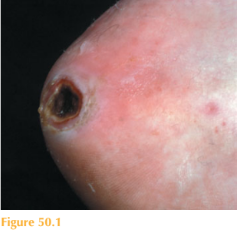History
You are asked to review a painful skin wound on the right heel of an 82-year-old man who is currently convalescing at a residential care home. He has been a resident of the home following a cerebrovascular accident two months ago and although he is show-ing signs of neurological recovery his mobility is limited by osteoarthritis of the hips and knees. He had coronary artery bypass grafting 8 years ago. He is an ex-smoker. His medications are aspirin 75 mg, atorvastatin 10 mg, lisinopril 10 mg and nifedipine 20 mg daily, as well as codeine and paracetamol prn for pain relief, and a prescription for prn haloperidol 1.5 mg.
Examination
He is a frail man with limited mobility during the examination. His blood pressure is 120/80 mmHg. He has a left-sided upper motor neurone weakness. He has a well-defined area of ulceration over the medial aspect of his left heel (Fig. 50.1). The ulcer is ‘punched out’ with a dry necrotic eschar overlying the base, the surrounding skin is erythematous. On examination of the arterial system of his legs, the femoral pulses are present but popliteal, posterior tibial and dorsalis pedis pulses are reduced on the left compared with the right. He has normal sensation in his feet. Ankle/brachial indices are measured and demonstrate an ankle pressure of 60 mmHg on the left and 80 mmHg on the right.

Questions
• What is the diagnosis?
• What are the likely factors in the aetiology of this ulcer?
• What is the optimum management?
The diagnosis in this patient is pressure or decubitus ulcer. The ulcer is located over a bony prominence. The history and examination showed that he has arterial disease, and ischaemia leading to tissue necrosis will be an important factor; however an ankle pres-sure of 50 mmHg is not considered to represent critical ischaemia. The presence of arterial disease is a poor prognostic feature.
Other contributing factors will be his age and his neurological impairment (particularly the combination of spasticity and paralysis) and reduced mobility due to arthritis.
Theappropriateness of the prescription for haloperidol should be considered, as excessive sedation will contribute to impaired sensory perception. Other factors to consider aremalnutrition, anaemia and incontinence. The aetiology of decubitus ulcers is generally a combination of pressure over bony prominences, shearing forces, destruction of the skin and compromised blood flow. The prevention and care of chronic lower leg ulceration places a significant burden patients and the health care system. Non-healing ulcers place the patient at risk for lower extremity amputation. Pressure relief is essential to the management of pressure ulcers using repositioning schedules and specialized beds. Management of incontinence to pre-vent contamination as well as wound cleaning and appropriate dressing are important to encourage healing and prevent bacterial secondary infection. Necrotic tissue may require surgical debridement. Measures to address immobility and spasticity, nutritional status and lower limb perfusion should be considered.
KEY POINTS
• Decubitus ulcers remain a significant cause of morbidity despite advances in their prevention, as well as active medical, surgical and nursing management.
• They particularly affect elderly persons with impaired sensation, prolonged immobility and other complex co-morbidities.
• Recognition and remediation of risk factors and, in particular, pressure relief are crucial to their prevention.
need an explanation for this answer? contact us directly to get an explanation for this answer